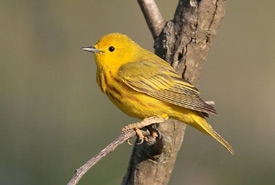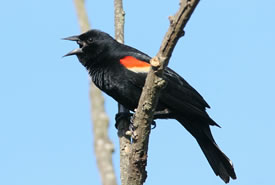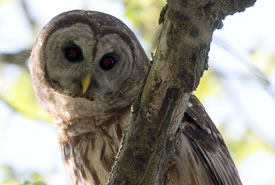Memorizing bird songs made easy with mnemonics

Yellow warbler (Photo by Wikimedia Commons)
I recall when I first heard a yellow warbler’s song; it was music against the backdrop of residential traffic in my suburban neighbourhood. At the time I had no clue where the bird was and I had no idea what bird was making this sound. I took out my phone, frantically trying to find the recording app while repeating the sound in my head over and over again: “Sweet sweet sweet sweet, sweeter than sweet!”
There are many features to help birders of all skill level identify a bird species. You’ll usually find a large part of a field guide’s description focused around structural characteristics such as silhouette, field marks, posture and size, while notes on behaviour and flight pattern provide added hints about the species' identity for birds in motion.

Red-winged blackbird (Photo by Bill Hubick)
But there is one aspect of bird identification that is not easily describable in words and harder to learn by the books, and that is the sound (calls and songs) a bird makes. More often than not you may hear a bird’s call or song but never actually get a visual confirmation, and that is why learning to identify birds by sound is so important, and fun as well!
Birds call for a variety of reasons: to communicate with other birds over a distance, to signal alarm and establish their territory, to name a few. Songs, on the other hand, are more specialized tunes composed of a series of notes and are usually associated with courtship. They are thought to be primarily a function of the male species, but studies find females sing too!
One of the tools to help with learning a bird song is mnemonics. This term is derived from an ancient Greek word μνημονικός (mnēmonikos) meaning “of memory” or “related to memory.” Mnemonic devices help learners connect unfamiliar and dissociated ideas. In the case of bird songs, mnemonics are often gimmicky phrases that help you string together the syllables and notes of a bird’s song so that you may remember its rhythm, pitch and tempo.
Let’s give one a try. Here is one bird whose song can be heard across Canada from spring through fall. Listen here >
Does it sound something like “Cheer up, cheerily, cheer up, cheerily”?

Barred Owl (Photo by Bill Hubick)
What about “Who cooks for you? Who cooks for you-all?” Sounds ridiculous, but I believe the mnemonic is spot on in describing the barred owl’s call! Hear it here >
While mnemonics can be really helpful, they don’t replace the hard work of learning by listening to recordings, going out to watch and listen, and following experienced birders out in the field. With practice (and starting with a few easily distinguishable tunes), you can earn your way to bragging rights next time someone asks you “What bird's song is that?”
Here are two fun comics to help you remember bird songs and calls.
Cartoons are reposted with permission from Bird and Moon.




